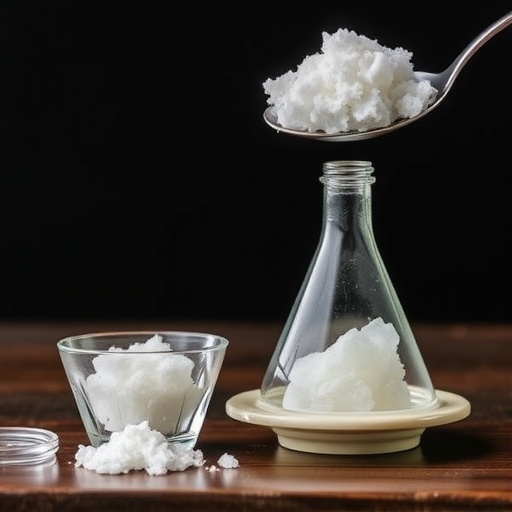In a world increasingly driven by health-conscious consumer choices, the demand for sugar alternatives has skyrocketed, prompting rigorous scientific inquiries into their prevalence and safety. A groundbreaking study emerging from Korea now sheds new light on erythritol, a widely used sugar alcohol known for its low-caloric content and minimal glycemic impact. This comprehensive investigation meticulously examines the occurrence of erythritol in an array of distributed food products within Korea, offering novel insights into exposure levels that could have profound implications for public health and regulatory frameworks.
Erythritol, chemically classified as a sugar alcohol or polyol, has gained immense popularity as a sugar substitute due to its unique metabolic pathways that render it virtually non-caloric. Unlike traditional sugars, it does not undergo significant metabolism by oral or gut microbiota, thereby minimizing the risk of dental caries and gastrointestinal discomfort commonly associated with other sweeteners. However, despite its widespread adoption in numerous food formulations—including beverages, confections, and baked goods—there has been a notable paucity of data quantifying actual erythritol exposure through real-world consumption patterns, especially within Asian markets.
To address this critical gap, researchers undertook an extensive survey, systematically collecting and analyzing a broad spectrum of foodstuffs commercially available in the Korean market. Utilizing cutting-edge chromatographic techniques combined with mass spectrometry, the team achieved precise quantification of erythritol concentrations, highlighting not only its ubiquitous presence but also the significant variability across different food categories. These analytical advancements underscore the importance of sophisticated methodologies in unraveling the complex chemical profiles embedded within modern food products.
.adsslot_zb2plvyFW8{ width:728px !important; height:90px !important; }
@media (max-width:1199px) { .adsslot_zb2plvyFW8{ width:468px !important; height:60px !important; } }
@media (max-width:767px) { .adsslot_zb2plvyFW8{ width:320px !important; height:50px !important; } }
ADVERTISEMENT
The findings reveal that erythritol is not merely a niche additive but a prevalent ingredient that permeates an array of widely consumed products. Particularly notable is the high prevalence in low-sugar or sugar-free beverages, where the compound frequently serves as a primary sweetening agent. In addition, various confectionery items and processed snacks demonstrated substantial erythritol content, reflecting current industry trends favoring formulary substitutions that cater to consumers’ growing desire to reduce caloric and sugar intake.
Beyond occurrence, the study delves into detailed exposure assessments by integrating consumption data reflecting Korean dietary habits. This multifaceted approach allowed the estimation of erythritol intake across diverse population segments, illuminating patterns that point towards potential cumulative effects. Such comprehensive exposure profiling is vital for regulatory agencies aiming to establish consumption guidelines that balance safety and innovation within the food industry.
Interestingly, the research juxtaposes erythritol exposure against established acceptable daily intake (ADI) parameters, exploring margins of safety with a critical eye. Despite erythritol’s generally recognized safety status, the researchers emphasize the necessity for continuous monitoring as consumption trends evolve. This cautious stance reflects an increasing awareness within the scientific community that even “safe” food additives may elicit unforeseen effects when intake levels reach or exceed certain thresholds, particularly over long-term consumption.
Moreover, the investigation addresses public health considerations pertinent to vulnerable groups such as children, pregnant women, and individuals with metabolic disorders. Given the increasing popularity of erythritol-containing products marketed as “healthier” options, it becomes imperative to understand exposure limits and potential risk factors comprehensively. The study contributes valuable data towards informing tailored dietary recommendations and honing food labeling regulations aimed at safeguarding consumer welfare.
Technological advancements in analytical science have enabled this pioneering research to provide unprecedented clarity on erythritol’s presence in the Korean food supply. Utilizing method validation protocols and stringent quality control measures, the researchers ensured reproducibility and reliability of their findings. Such rigor not only bolsters confidence in the results but also sets a benchmark for future investigations worldwide seeking to map the landscape of sugar alcohol prevalence and safety.
This research carries broader implications beyond Korea’s borders, resonating with global trends in sugar reduction initiatives. As countries grapple with rising incidences of obesity, diabetes, and cardiovascular disease, erythritol and other non-nutritive sweeteners offer promising avenues for formulating healthier food options. Nevertheless, this study exemplifies the critical need for empirical data underpinning these efforts, dispelling assumptions and fostering evidence-based policymaking.
The intricate balance between innovation and safety emerges as a central theme. The food industry’s accelerated adoption of erythritol mirrors consumer demand but also necessitates vigilant oversight. As new consumption data emerges, regulatory bodies must remain agile, adapting frameworks to reflect scientific advancements. This dynamic underscores the essential collaboration between researchers, policymakers, and manufacturers in ensuring that public health remains paramount amidst rapid food science developments.
Finally, this study catalyzes broader discourse on sustainable nutrition strategies. Erythritol’s production methods, environmental footprint, and socio-economic impacts constitute complementary dimensions warranting exploration. Integrating these considerations fosters holistic approaches aligned with global sustainability goals, augmenting erythritol’s appeal beyond isolated health benefits.
In conclusion, this landmark Korean study profoundly enriches our understanding of erythritol’s pervasiveness and exposure through everyday foods. It reinforces the imperative for rigorous surveillance and data-driven evaluations as the food landscape continues to evolve. By illuminating the nuanced interactions between dietary practices, additive use, and health outcomes, it paves the way for safer and smarter nutritional paradigms that resonate with contemporary public health imperatives.
Subject of Research: Occurrence and exposure assessment of erythritol in distributed foods in Korea
Article Title: Occurrence and exposure assessment of erythritol from distributed foods in Korea
Article References:
Kim, Kw., Chung, H., Shin, C. et al. Occurrence and exposure assessment of erythritol from distributed foods in Korea. Food Sci Biotechnol (2025). https://doi.org/10.1007/s10068-025-01948-2
Image Credits: AI Generated
DOI: https://doi.org/10.1007/s10068-025-01948-2
Tags: dietary erythritol exposureErythritol analysis in Korean foodserythritol and public healtherythritol in beverages and confectionsfood safety and sugar substituteshealth impacts of erythritolKorean food products surveylow-caloric sweetenersmetabolic pathways of erythritolregulatory implications of erythritolsugar alcohol consumption patternssugar alternatives in Korea





